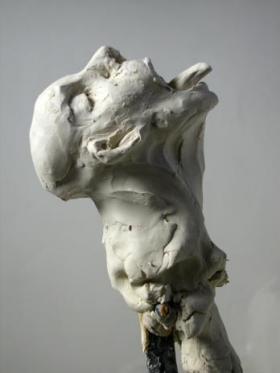Lydie Arick "Etat de grâce"
“ Etat de grâce” (State of grace) Is it necessary that life is tested, that the body falls, that tiredness is transformed into extenuation so that work remains in an excess of energy ? That it is renewed, against life or alongside it, which takes shape in its fractures and its chaos? One can ask this question regarding the recent works on paper by Lydie Arickx whose preceding exhibition was called, not only symbolically, “Un genou en terre” (“grounded knee”). In her studio in Saint-Geours-en-Maremnes, there are piles of drawings, thrown one on the other, like fragile skins, amalgamated pages of hardly-dry oil pastels, a graphic and autobiographical diary of drawings, written under the impulse and the drastic desire to register order, a readable truth and an obligation to resist a lapse of memory. An impulse that Lydie Arickx translates by fragments of body, faces which retract, osseous backs and hands sealed in offering. Louise Bourgeois wrote about Francis Bacon a text which throws light on the idea of impulse. “He did not look at the things but painted from desire. To paint was an interior voyage, and thus its relation to the real world was obviously deformed. Bacon painted the impact of adrenalin in the nervous system that the obsessional need to express causes” In the same way, Lydie Arickx endeavours to deny the form registered of her temporal context but painting after painting, distils precise sequences like these bodies offered while falling, in the effort, in tension or in abandonment.
This choreography obliterates the anatomy, she appoints a way of “writing the drawings”, starting with a da sh, on the basis of something seen to be extracted, an abundance of marks like will-o'-the-wisps which formulate, more than they enclose, a strange maceration of matter, earth or flesh one does not know any more, marbling, pigment retention, cracks, aqueous streams or holes which create crevasses on the paper.
That one observes the faces carried out on these brown backgrounds, portraits on rare Tibetan papers, taken at a low-angle shot, nostrils offered like a tracked animal, mouth open wide like in the “The Scream” of Munch, and one will find this particular use of layering and the sedimentation of the colour to depict an ancestral humanity, ageless, but not painless. Because these imagined bodies, “turning around to reveal themselves” or these faces which could have called themselves, “These heads on which we walk”, divulges Lydie Arickx, evoke a base, a heritage and an aggregation of the ages and human generations in which we live. In the same way, these small white porcelain heads, obtained by biscuit firing, form, joined together like a bouquet of lilies, a kind of precious frieze of different and common faces.
Faces of the rising dawn whose singular union seems to take force by fixing a remote space, invisible and yet perfectly tangible. Thus, this “state of grace” in question throughout this exhibition, signs, here and now, a vital creation, an attention related to the experiment of disappearance, as the painful notebooks depict, joined together under the title “Ecume de mère” (“ Mothers/sea spume”), pages of notes and drawings detailing, even in its more abrupt aspects, the narrative of the hospitalization and the recent passing away of the artist’s mother.
It is among the beautiful drawings which exist about suffering, the withdrawal of the breath, the retracting body, the fading face. In echo, these new works present spreading bodies, revealing glances wich consider everywhere a serene face to face. Relieved. Death is a humus, mourning a condition.
Laurent Boudier 2005
